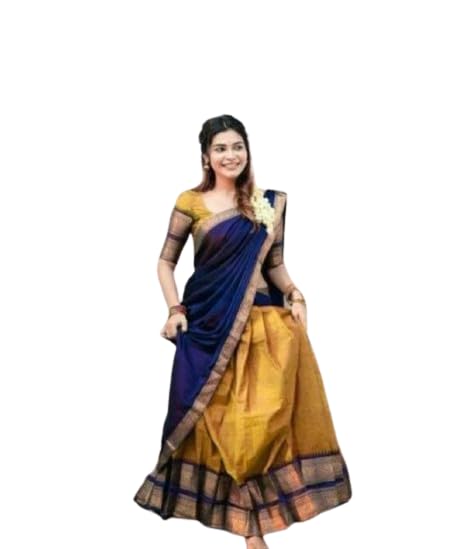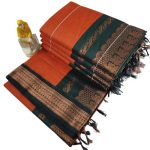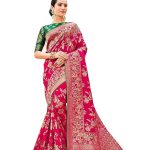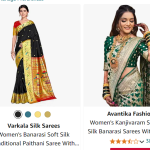A half saree is a traditional South Indian attire that holds cultural significance and charm. It is a symbol of a girl’s transition from childhood to adulthood in many parts of India. The blue and yellow half saree adds a vibrant modern touch to this traditional outfit, making it an eye-catching and elegant choice for various occasions. This article will dive deep into every detail you need to know about this beautiful garment, from how to wear it safely, to pricing details across different countries, and even discounts available.
Advertisements
DEWASU Kanjeevaram Pure Zari Silk Traditional Unstitch umbrella Lehenga Choli, Half Saree For Women
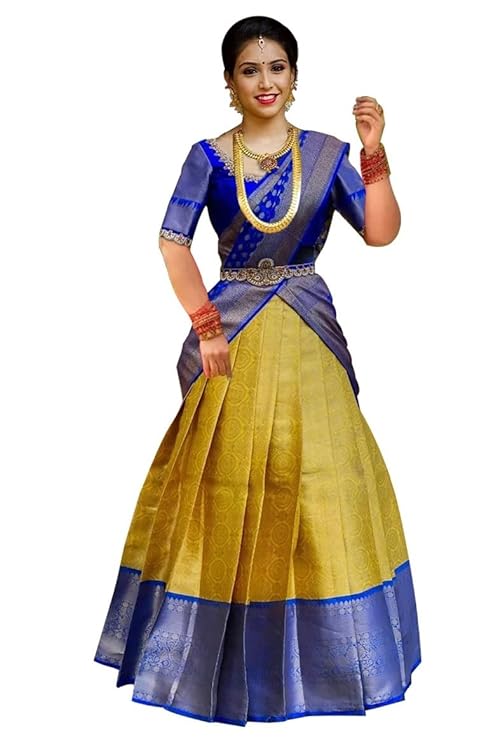
Product details
Material composition : Pure Zari Silk
Length : 6 yards
Neck style : U-Neck
Pattern : Half & Half
Care instructions : Dry Clean Only
Country of Origin : India
MORPANKH DESIGNER South Indian Style Unstich Traditional Lehenga Choli For Women
Product details
Material composition : Silk
Weave type : Woven
Finish type : Unstitched
Care instructions : Dry Clean Only
Sleeve type : Half Sleeve
Material type : Silk
Country of Origin : India
Product Details
The blue and yellow half saree usually consists of three pieces:
- Lehenga (Skirt): The lower part of the outfit, usually worn at waist level. In a typical blue and yellow half saree, the lehenga is often blue, made from fabrics such as silk, cotton, or georgette, which provide a flowy and graceful appearance.
- Choli (Blouse): This is the upper garment, often contrasting in color with the lehenga. The blouse in a blue and yellow saree set is usually yellow and can come in various designs like sleeveless, short sleeves, or long sleeves, depending on personal preference.
- Dupatta (Saree Drape): A long piece of fabric draped over the lehenga and blouse. This is where the blue and yellow half saree gets its signature look, as the dupatta often mixes both colors, creating a harmonious and fashionable effect.
The materials used for these sarees vary, from lightweight cotton for casual wear to heavily embellished silk and georgette for weddings and parties.
How to Use the Product Safely
When wearing a blue and yellow half saree, there are a few key points to ensure it is used safely and comfortably:
- Fitting: Ensure that the lehenga and choli are well-fitted to avoid discomfort. Ill-fitting clothes can cause discomfort, especially during long events.
- Securing the Dupatta: Use safety pins to secure the dupatta in place while draping. This prevents accidental slipping, which can lead to tripping or feeling uncomfortable.
- Proper Footwear: Half sarees are best worn with comfortable footwear. High heels can enhance the look, but they should be comfortable to walk and stand in, especially for long hours.
- Avoid Sharp Accessories: Be mindful when choosing jewelry and accessories. Sharp edges can pull at the delicate fabric of the saree, damaging it over time.
- Storing: Store the saree in a clean, dry place to preserve its fabric. Preferably, use a saree cover to protect it from dust and moisture.
- Washing and Ironing: Always read the washing instructions provided. Delicate fabrics like silk and georgette should be dry-cleaned, while cotton variants can be hand-washed. Use a low heat setting while ironing to prevent damage to the fabric.
Pros and Cons of the Blue and Yellow Half Saree
Before purchasing a blue and yellow half saree, it’s important to weigh the advantages and disadvantages:
Pros:
- Elegant and Traditional: Half sarees provide a perfect blend of tradition and modern style. The blue and yellow color combination is especially vibrant and suitable for special occasions.
- Comfortable: Half sarees are typically more comfortable than full sarees as they require less fabric and are easier to manage.
- Versatile: This attire can be worn at weddings, festivals, and even casual events, depending on the fabric and embellishments.
- Customization: These sarees often come with customization options where you can choose the type of blouse and lehenga design.
- Youthful Appeal: They are a popular choice among young women due to their playful yet elegant design.
Advertisements
Cons:
- Pricey for Heavily Embellished Designs: Silk or heavily embellished versions can be quite expensive, making them a less budget-friendly option.
- Challenging to Drape for Beginners: While half sarees are simpler than full sarees, draping the dupatta can still be tricky for someone unfamiliar with traditional attire.
- Maintenance: Special care is needed for silk and georgette fabrics, and regular dry cleaning can become expensive over time.
- Limited Occasion Use: Half sarees, particularly heavily embellished ones, may not be suitable for everyday wear, restricting them to special occasions.
Complete Price Detail from Multiple Countries
The price of a blue and yellow half saree varies depending on the fabric, the level of embellishment, and the brand. Below is a price guide from different countries:
- India:
- Cotton or georgette half sarees: INR 3,000 to INR 7,000.
- Silk and embellished half sarees: INR 8,000 to INR 25,000.
- USA:
- Imported cotton half sarees: $50 to $120.
- Silk and heavily embellished half sarees: $150 to $500.
- UK:
- Cotton half sarees: £40 to £100.
- Designer silk half sarees: £120 to £350.
- Australia:
- Basic cotton half sarees: AUD 70 to AUD 150.
- Silk and georgette designer sarees: AUD 200 to AUD 500.
- Canada:
- Cotton sarees: CAD 60 to CAD 130.
- Embellished silk sarees: CAD 160 to CAD 450.
Discount Coupons
Occasionally, companies or retailers offer discount coupons for blue and yellow half sarees, especially during festive seasons. Here are some possible coupon opportunities:
- Festive Sales: Discounts ranging from 10% to 30% during Diwali, Dussehra, or Pongal.
- Online Retailers: Platforms like Amazon, Flipkart, or Myntra often issue discount coupons for traditional wear during promotional periods.
- Loyalty Coupons: Some boutiques or designers may offer loyalty points or coupons for returning customers, typically providing 5% to 15% off.
- Student Discounts: Some online platforms offer student discount programs, providing savings of up to 10% on traditional attire.
Before purchasing, always check the retailer’s website for active coupons or promotional codes.
Frequently Asked Questions (FAQs)
1. What occasions can I wear a blue and yellow half saree to?
The blue and yellow half saree is ideal for weddings, festivals, and traditional ceremonies. It can also be worn at casual events, depending on the fabric and design.
2. How do I choose the right fabric for a half saree?
For casual or summer wear, cotton and georgette are good options due to their breathability. For formal occasions, silk or satin is more appropriate, as these fabrics add elegance to the attire.
3. How do I drape the dupatta of a half saree?
The dupatta is usually draped over the shoulder, similar to a regular saree. However, you can experiment with different styles, such as tucking it at the waist or pinning it on both shoulders for added security.
4. Can I customize my half saree?
Yes, many retailers offer customization options where you can choose the blouse style, sleeve length, and lehenga design.
Advertisements
5. How do I care for my blue and yellow half saree?
Always follow the care instructions provided by the seller. Typically, silk and embellished sarees should be dry-cleaned, while cotton and georgette sarees can be hand-washed with mild detergent.
6. Are there any seasonal discounts on half sarees?
Yes, festive seasons like Diwali, Navratri, or Christmas often see discounts of 10% to 30% on traditional attire.
7. Is a half saree comfortable to wear for long hours?
Yes, half sarees are generally comfortable, especially if they are made from breathable fabrics like cotton or georgette. Ensure that the fit is right and the dupatta is securely pinned to avoid discomfort.
8. What kind of jewelry pairs well with a blue and yellow half saree?
Traditional jewelry like gold, pearls, or kundan sets complements the elegance of a blue and yellow half saree. However, you can also experiment with modern jewelry for a fusion look.
9. Can I wear a half saree for everyday use?
While half sarees are traditionally worn for special occasions, simpler designs made from cotton or georgette can be worn for everyday use, especially in warmer climates.
10. How do I ensure the saree doesn’t slip while walking or dancing?
Use safety pins to secure the dupatta at the shoulder and waist. You can also use double-sided fashion tape to ensure the saree stays in place during movement.

